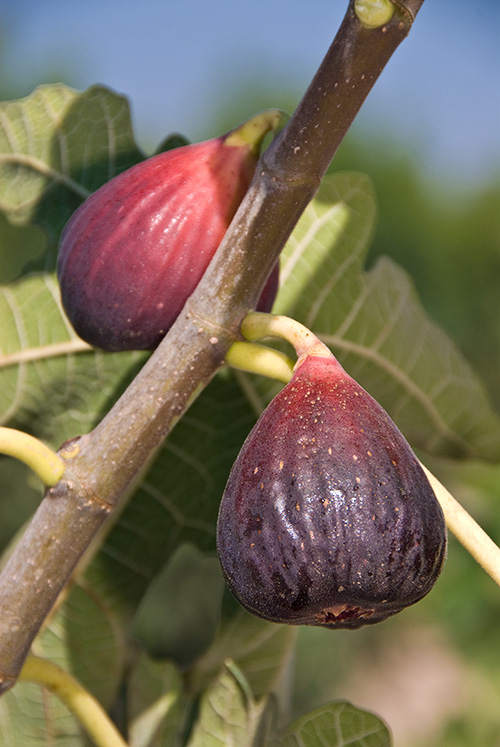Question: I have 2 questions:
1. what is the difference between brown turkey fig and improved brown turkey fig?
2. what is the difference between kadota fig and janice kadota fig?
Richard
Answer:
Richard,
1. We grow the "unimproved" Brown Turkey Fig which has been a popular, proven, tasty "heirloom" variety for hundreds of years and across a wide range of countries and climates.

Brown Turkey Fig
I believe the "Improved" Brown Turkey Fig you mention is the same as Thompson's Improved Brown Turkey Fig and California Brown Turkey which has been around since the 1800s. According to Ira Condit, the proper name for this variety is San Piero. Here is what he says about it :
"The Thompson, or Thompson Improved Brown Turkey, is identical with San Piero. The same is true of Granata, grown by B. R. Amend, Portland, Oregon. The following account is based on trees in production at Riverside since 1930.
Trees are vigorous, precocious, very productive, often somewhat dwarfed by heavy crops; terminal buds violet-brown. Leaves medium to large, somewhat glossy above, variable as to lobing; some are 3-lobed, with upper sinuses shallow, others 5-lobed, with upper sinuses of medium depth, lower sinuses shallow; basal lobes commonly auricled (especially on leaves of sucker growth), with the borders overlapping; margins coarsely crenate.
Breba crop fair, stimulated by terminal-bud pruning of dormant twigs, as described by Hodgson (1925); figs large, up to 3-3/4 inches long and 2-1/2 inches in diameter, oblique-pyriform, sometimes elongated; average weight 105 grams; neck thick and short, merging gradually into body; stalk thick and short; ribs prominent, generally coloring earlier and deeper than body; eye large, open, scales tinted pink, even on immature fruit; white flecks numerous, variable in size; color greenish purple, darker on side exposed to sun and on the apex; bloom delicate, pruinose; meat violet; pulp strawberry; flavor rich; quality good. (Plate 24, A.)
Second-crop figs medium to large, or commonly very large on sucker wood of heavily pruned trees, obovate to oblique-pyriform; average weight 70 grams; neck variable, thick and short, or sometimes up to 1/2 inch long and curved; ribs prominent; eye large, open, scales purple; surface somewhat glossy, with prominent bloom; white flecks large, scattered, some elongated, violet at maturity; color purplish black, with lighter shades on neck; pulp strawberry, center hollow, as shown in plate 11 and by Condit (1941a, fig. 11, A); flavor fairly rich. Quality fair to good when matured on the tree. Consumed fresh; worthless for drying, on account of poor color and susceptibility to spoilage, therefore seldom grown in the San Joaquin Valley."
Here is a case where "Improved" may not be improved for everyone. I am not sure what is "Improved" about it. It does well at the coast but freezes easier and does not do well in typically great, hot fig climates like the San Joaquin Valley were we are located. On the other hand, the "unimproved" Brown Turkey that we grow has a wider climate range from the coast to inland heat and can go into colder climates.
2. The Janice Kadota Fig is a relatively new (Patented in 1991) fig that features a soft or non brittle endocarp (thus called "seedless" or nearly so). It came from a sport off a Kadota (White Kadota) Fig. Other than what I read on a Google search, I know very little about it. According to its patent paperwork, it might be a fraction of an inch larger that the White Kadota. At one time we grew and sold the Marylane Seedless Fig which was also a white, nearly seedless fig. We dropped it after many years since there was not much demad for it. I will have to look into adding that Janice Fig to our fig tree collection and evaluate it.

